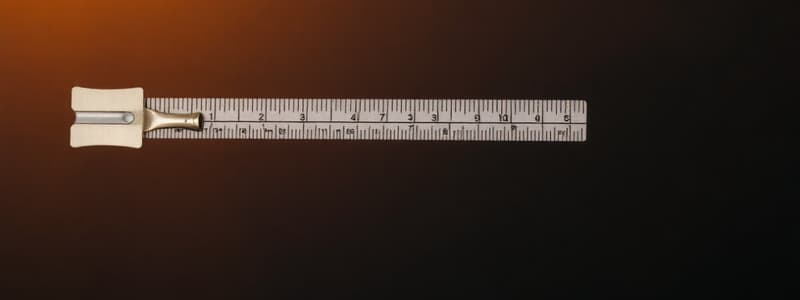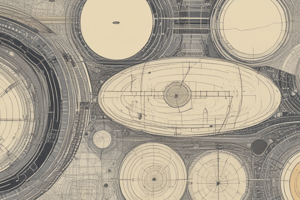Podcast
Questions and Answers
What are the two main components of every measurement?
What are the two main components of every measurement?
The two main components of every measurement are a numerical value and a unit.
Why are standard units of measurement necessary?
Why are standard units of measurement necessary?
Standard units of measurement are necessary to maintain uniformity and reliability, as human body parts vary in size among individuals.
What is the SI unit of length and how is it defined?
What is the SI unit of length and how is it defined?
The SI unit of length is the metre (m), defined as the distance between two fine marks on a platinum-iridium bar at the International Bureau of Weights and Measures.
List two instruments used to measure length and their specific applications.
List two instruments used to measure length and their specific applications.
What is the purpose of multiple and submultiple units in measurement?
What is the purpose of multiple and submultiple units in measurement?
Explain the significance of a light year as a unit of distance.
Explain the significance of a light year as a unit of distance.
What rules should be followed when writing unit symbols?
What rules should be followed when writing unit symbols?
What are microns and angstroms used to measure?
What are microns and angstroms used to measure?
What is a stopwatch used for?
What is a stopwatch used for?
What are the two commonly used units for measuring temperature?
What are the two commonly used units for measuring temperature?
What is the SI unit for temperature?
What is the SI unit for temperature?
How does a laboratory thermometer function?
How does a laboratory thermometer function?
What does a clinical thermometer measure?
What does a clinical thermometer measure?
What is the relation to convert Celsius to Fahrenheit?
What is the relation to convert Celsius to Fahrenheit?
What defines the concept of accuracy in measurements?
What defines the concept of accuracy in measurements?
What are the characteristics of a correct metre scale?
What are the characteristics of a correct metre scale?
Describe the typical range of a clinical thermometer.
Describe the typical range of a clinical thermometer.
What role does the Department of Weights and Measures play in India?
What role does the Department of Weights and Measures play in India?
What is parallax error in measuring length, and how can it be minimized?
What is parallax error in measuring length, and how can it be minimized?
Describe the method to measure the diameter of a spherical object.
Describe the method to measure the diameter of a spherical object.
How can you measure the length of a curved object?
How can you measure the length of a curved object?
What is the procedure for measuring the diameter of a wire?
What is the procedure for measuring the diameter of a wire?
Explain how to determine the thickness of a rupee coin using a stack of coins.
Explain how to determine the thickness of a rupee coin using a stack of coins.
Convert 1 foot to centimeters.
Convert 1 foot to centimeters.
What is the SI unit of mass, and how does it differ from weight?
What is the SI unit of mass, and how does it differ from weight?
How does a beam balance work, and what are its key requirements?
How does a beam balance work, and what are its key requirements?
What precautions should be taken when using a physical balance?
What precautions should be taken when using a physical balance?
Describe how an electronic balance measures weight.
Describe how an electronic balance measures weight.
What is the SI unit of time and how is time defined?
What is the SI unit of time and how is time defined?
How can the method of graph paper be used to measure the area of an irregular shape?
How can the method of graph paper be used to measure the area of an irregular shape?
What materials are commonly used in the construction of a physical balance?
What materials are commonly used in the construction of a physical balance?
What is the relationship between mass and weight?
What is the relationship between mass and weight?
Why is it essential to keep electronic balances dry and properly calibrated?
Why is it essential to keep electronic balances dry and properly calibrated?
Flashcards are hidden until you start studying
Study Notes
Measurement and Physical Quantities
- Measurement compares an unknown quantity with a known constant or unit.
- Every measurement consists of a numerical value and a unit.
- A physical quantity can be defined as: Physical quantity = Numerical value × unit.
- Standard units ensure uniformity and reliability in measurements, avoiding discrepancies due to human body variations.
Need for Standard Units
- Prior to standard units, measurements were inconsistent.
- Standard units are defined by characteristics that include being of moderate size, unaffected by space and time, unambiguous, non-perishable, and easily reproducible.
Rules for Writing Units
- Unit names are written in lower case, except Celsius and Fahrenheit.
- Symbols for units named after scientists are in upper case, while other symbols remain in lower case.
- Units should not be followed by a full stop and written in plural form only when in words.
Measurement of Length
- Length is the distance between two points; the SI unit is the metre (m).
- A metre is based on a platinum-iridium bar kept in Paris.
- Tools for measuring length include rulers, measuring tapes, vernier calipers, and screw gauges.
- Common units include multiples (kilometre, hectometre) and submultiples (decimetre, centimetre, millimetre).
- Light-year measures astronomical distances, and microscopic measurements use microns and angstroms.
Measuring Techniques
- Accurate measurement requires proper placement and alignment to avoid parallax error.
- For spherical objects, measure diameter using solid blocks and a metre scale.
- Curved lengths can be measured using a thread, while the thickness of small objects can be determined by stacking.
Measurement of Area
- Area represents the surface enclosed by a boundary, measured in square metres (m²).
- Regular and irregular areas are assessed differently, with formulas and graph paper used respectively.
Mass and Weight
- Mass indicates the amount of matter in an object, while weight represents gravitational force acting on it.
- SI unit of mass is kilogram (kg); subunits include gram and milligram.
- Balance scales (grocer’s, beam, physical, electronic) are used to measure mass accurately.
Measurement of Time
- Time represents the interval between events; the SI unit is the second (s).
- Historical methods included sundials; modern timekeeping uses atomic clocks.
- Devices include clocks, watches, and stopwatches for various measurements.
Measurement of Temperature
- Temperature indicates the degree of hotness or coldness, measured with thermometers.
- SI unit is Kelvin; common scales are Celsius and Fahrenheit.
- Laboratory thermometers measure up to -100°C to 110°C, while clinical thermometers measure human body temperature.
Approximation in Measurement
- Approximation provides a quick but not exact measurement; accuracy reflects closeness to the true value.
- Errors can be mitigated by averaging multiple observations.
Standard Weights and Measures
- The Department of Weights and Measures in India ensures correctness of weights and measuring devices.
- Characteristics of accurate measuring devices include verification stamps and correct functionalities.
Studying That Suits You
Use AI to generate personalized quizzes and flashcards to suit your learning preferences.




